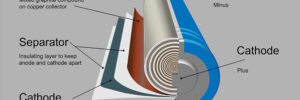
The global supply of graphite, a critical component of Li-ion battery anodes, could soon represent a major bottleneck for EV production.
Supply chain experts have been sounding alarms about graphite for some time. Some months ago, Benchmark Mineral Intelligence was already reporting that “the potential graphite supply crunch is arguably one of the most acute and underappreciated across all battery raw materials.”
Then came China’s surprise announcement that it would impose new export controls on graphite. The country could use the new rules, which take effect on December 1, to reduce exports of graphite, or to prioritize exports to Chinese-owned companies.
How big a deal is this? Charged reached out to John DeMaio, CEO of Graphex, a volume producer of spherical graphite for Li-ion battery anodes (we published a feature interview with Mr. DeMaio in February). He confirmed that “this restriction is a very big deal.”
According to Benchmark Mineral Intelligence, China controls 75% of the supply chain for natural graphite and 74% of the chain for synthetic graphite (battery-makers blend natural and synthetic graphite in various formulations). However, as DeMaio explains, “That number belies even greater control at certain points within that chain. While China mines ‘only’ 67% of the world’s natural graphite, and produces 79% of the world’s anode material, it controls a whopping 99% of spherical graphite production, meaning it has a virtual chokehold on that key midstream processing step.”
How dire is the threat to US battery makers? “So far, the major threat to supply chains is not acute shortage but fear of shortage—and uncertainty that makes it difficult to plan,” DeMaio told Charged. “As with germanium and gallium, which saw export permit mandates earlier this year, China is requiring export permits but not (yet) explicitly restricting the number of permits available. Whether the move is geopolitically motivated, as some Americans suspect, or simply out of concern for preserving sufficient domestic supply, as China claims, the fact that China could severely tighten global graphite supply at any moment creates a dangerous market uncertainty.”
Efforts to build domestic graphite supply chains are already underway, but much more needs to be done. “This announcement is a loud wakeup call and a national security issue for the US and Canada,” says DeMaio. “Many graphite miners and processors were already looking to North America to expand and diversify their capacity to mine and process graphite outside China. But this announcement highlights the need for North America to have a graphite supply chain independent of China in a way that’s clear even to people not in the graphite trenches.”
“For automakers, their response to this announcement will come down to identifying new mines already online, then partnering with midstream processors that have the technical know-how to transform raw flake graphite into anode material,” says DeMaio. “What would really spur commitment, to support domestic supply chain buildout on the automaker side, would be the combination of this China threat with stable, committed growth in EV demand. Concern isn’t yet at a fever pitch, partially because a cooling economy has lessened demand for new electric cars. The China announcement is just one more uncertainty for many automakers as they consider how to scale their EV business. But take a step back, and the direction towards vehicle electrification is clear—as is the concomitant need for stable, abundant, domestic capacity to mine and process graphite. I think this announcement will absolutely help North America to kickstart their mineral onshoring plans.”
Sources: Graphex, New York Times, Benchmark Mineral Intelligence
from Charged EVs https://ift.tt/HCFMoAp



No comments:
Post a Comment